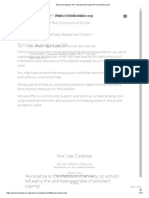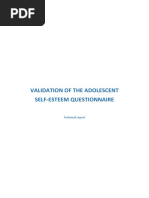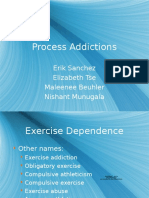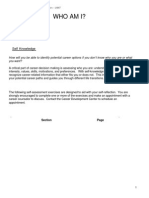Social Communication Questionnaire (SCQ)
Social Communication Questionnaire (SCQ)
Uploaded by
Wade WilsonCopyright:
Available Formats
Social Communication Questionnaire (SCQ)
Social Communication Questionnaire (SCQ)
Uploaded by
Wade WilsonOriginal Description:
Original Title
Copyright
Available Formats
Share this document
Did you find this document useful?
Is this content inappropriate?
Copyright:
Available Formats
Social Communication Questionnaire (SCQ)
Social Communication Questionnaire (SCQ)
Uploaded by
Wade WilsonCopyright:
Available Formats
SOCIAL COMMUNICATION QUESTIONNAIRE (SCQ)
The Social Communication Questionnaire (SCQ) is one tool clinicians use when
screening an individual for Autism Spectrum Disorder (ASD). It is a measure for
caregivers to complete. Caregivers need to be familiar with the individual’s
developmental history and current behavior. It is used in both clinical and research
settings.
Name Social Communication Questionnaire (SCQ)
Reference Rutter M, Bailey A & Lord C (2003). The Social
Communication Questionnaire. Los Angeles: Western
Psychological Services
Summary The SCQ is widely used as a screener for entry into
research studies on ASD. It was designed as a
questionnaire version of the Autism Diagnostic
Interview – Revised (ADI-R), the gold standard
developmental history measure that is widely used in
research and often in clinical practice. Caregivers can
rate the individual’s “lifetime” characteristics (which
would be used to support a diagnosis) or “current”
characteristics (which would be used to support an
evaluation of current difficulties). Like most
questionnaires, it was primarily developed on
individuals who had already been clinically referred
because of concerns of ASD or who had already been
diagnosed. However, compared to other rating scales,
the development research was significantly more
robust, including good diagnostic validation on
participants, and it has been widely adopted by both
the research and clinical community.
Age Range The individual should have a mental age of at least 2.0
years. Otherwise, this measure can be used with
individuals of any chronological age.
Format Two versions: Lifetime and Current. Each is a 40-item
parent report measure, yes/no format. Each take
approximately 10 minutes to complete, 5 minutes to
score.
Who Can Rate The SCQ is completed by the principal caregiver who is
familiar with both the developmental history and
current behavior of the individual.
Who Can Interpret The SCQ score should be interpreted by someone with
professional training in the care and treatment of
individuals on the autism spectrum.
Results Yielded The Lifetime version yields a Total Score that is
interpreted with reference to cutoff scores. Scores
above the cutoff of 15 suggest the individual is likely to
be on the autism spectrum and a more extended
evaluation should be undertaken. Researchers may
want to use a lower or higher cutoff depending on the
purpose (for example, a lower cutoff would increase
sensitivity, a higher cutoff would increase specificity).
Current scores (last 3 months) help the clinician
understand the individual’s current daily experiences
and evaluate treatment and educational plans.The 3
domains of Social Relating, Communication, and Range
of Interests can also be scored, but the utility of this
has not been widely researched.
Author’s This was created as a screening instrument; scores
Suggested Uses above the cutoff suggest that a full evaluation (for
example, using the ADI-R and Autism Diagnostic
Observation Schedule – “ADOS”) is warranted. It may
be possible to use this measure to compare overall
levels of ASD symptomatology across different samples
and/or across time. The Current form may be helpful as
a measure of current level of severity, but this has not
been well studied.
Author Cautions As a screening measure, the SCQ is not suitable for
individual diagnosis; items must be compared to clinical
observations. Scores at the cutoff (as opposed to above
the cutoff) may need to be examined as potential false
negatives. No data has been reported on false
positives. Finally, there is limited data on non-ASD
conditions that involve overlapping difficulties (for
example, Attachment Disorder, ADHD, OCD).
Item Development Items came from the ADI-R, which is considered the
“gold standard” measure for gathering developmental
history related to ASD.
Development Three samples were used for developing this measure.
Research Unlike many rating scales, these individuals had
extensive diagnostic and clinical data available through
previous or concurrent participation in other research
studies. Sample 1: 200 individuals (160 with confirmed
ASD diagnoses, 40 individuals without an ASD diagnosis
but with other developmental or behavioral diagnoses).
All parents had participated in an ADI-R (often years
before) and were then asked to complete the SCQ.
Sample 2: 21 children. Parents were asked to complete
the SCQ and then participated in an ADI-R. Sample 3:
81 individuals. Parents completed the SCQ and then an
ADI-R 2 months later.
Related Articles:
Getting an Evaluation for Autism Spectrum Disorder
Who is Able to Diagnose Autism Spectrum Disorder
Elements of an Evaluation for Autism Spectrum Disorder
The Center for Autism Research and The Children's Hospital of Philadelphia do not endorse or recommend any specific person or organization or form
of treatment . The information included within the CAR Autism Roadmap & trade; and CAR Resource Directory & trade; should not be considered
medical advice and should serve only as a guide to resources publicly and privately available . Choosing a treatment, course of action, and/or a
resource is a personal decision, which should take into account each individual's and family's particular circumstances .
You might also like
- Language Aptitude TestDocument13 pagesLanguage Aptitude TestSiti Hajar Zaid100% (3)
- Course Outline FSF1DDocument10 pagesCourse Outline FSF1DMd Aminul HaqueNo ratings yet
- Clinical Applications of The Pe Mark A. Blais Matthew R. BaityDocument257 pagesClinical Applications of The Pe Mark A. Blais Matthew R. BaityJulan del ToroNo ratings yet
- Beck Depression Inventory (BDI)Document6 pagesBeck Depression Inventory (BDI)dmhp paschim medinipurNo ratings yet
- Emotional CPR (eCPR) Certification Training: VenueDocument1 pageEmotional CPR (eCPR) Certification Training: VenueSharon A StockerNo ratings yet
- CTF Art Lesson Sequence DraftDocument11 pagesCTF Art Lesson Sequence Draftapi-401010000No ratings yet
- Bertalanffy Outline General System TheoryDocument22 pagesBertalanffy Outline General System TheoryecotrabalhoNo ratings yet
- Are You Gossiping About Me? The Costs and Benefits of High Workplace Gossip PrevalenceDocument18 pagesAre You Gossiping About Me? The Costs and Benefits of High Workplace Gossip Prevalencevs159096No ratings yet
- ChestionarDocument1 pageChestionarRoxanaElenaNo ratings yet
- Park 2021 Comprehensive Resiliency Framework Theoretical Model TreatmentDocument10 pagesPark 2021 Comprehensive Resiliency Framework Theoretical Model TreatmentMichel MaragelNo ratings yet
- Soclal Work Vol 4 S - YDocument402 pagesSoclal Work Vol 4 S - YBurbak OfficialNo ratings yet
- 1968 - Kiresuk, T. Sherman, R.Document11 pages1968 - Kiresuk, T. Sherman, R.nataliacnNo ratings yet
- Vba 21 0960p 3 Are PTSD ReviewDocument6 pagesVba 21 0960p 3 Are PTSD ReviewCombat CraigNo ratings yet
- J Organ Behavior - 2022 - Sun - Workplace Gossip An Integrative Review of Its Antecedents Functions and ConsequencesDocument24 pagesJ Organ Behavior - 2022 - Sun - Workplace Gossip An Integrative Review of Its Antecedents Functions and ConsequencesDavid RodríguezNo ratings yet
- Sleep-Wake Disorders Fact Sheet PDFDocument2 pagesSleep-Wake Disorders Fact Sheet PDFAle M. MartinezNo ratings yet
- School Avoidance 101 - Assessment Scale & Parent ResourcesDocument13 pagesSchool Avoidance 101 - Assessment Scale & Parent Resourcesamrut muzumdarNo ratings yet
- Psych 2014093011461253 PDFDocument42 pagesPsych 2014093011461253 PDFjuanpaulomunera2No ratings yet
- Pemberton Happiness Index PDFDocument13 pagesPemberton Happiness Index PDFIesanu MaraNo ratings yet
- Curriculum OF Psychology BS/MS: (Revised 2013)Document226 pagesCurriculum OF Psychology BS/MS: (Revised 2013)Faiza Rasul0% (1)
- The Dispositional Flow Scale-2 As A Measure of Autotelic PersonalityDocument7 pagesThe Dispositional Flow Scale-2 As A Measure of Autotelic PersonalityRuqayya OmarNo ratings yet
- IDEASDocument11 pagesIDEASsri nandiniNo ratings yet
- Unit 1 Play Therapy: StructureDocument10 pagesUnit 1 Play Therapy: StructureabcdNo ratings yet
- LCSW Supervision Information 1Document1 pageLCSW Supervision Information 1MariamNourNo ratings yet
- Clinical InterviewDocument4 pagesClinical InterviewHazal KhanNo ratings yet
- Strong Interest InventoryDocument32 pagesStrong Interest InventoryTattsunNo ratings yet
- Health Anxiety Inventory PDFDocument4 pagesHealth Anxiety Inventory PDFSana SajidNo ratings yet
- CESD-R - Center For Epidemiologic Studies Depression Scale Revised Online Depression Assessment CESD-R ExplanationDocument2 pagesCESD-R - Center For Epidemiologic Studies Depression Scale Revised Online Depression Assessment CESD-R ExplanationMi RoNo ratings yet
- NASW Technology Standards 2017Document64 pagesNASW Technology Standards 2017Nikki HoseiNo ratings yet
- Play TherapyDocument7 pagesPlay TherapyBhAVya 27No ratings yet
- Who Das 2.0 Versi Asli PDFDocument9 pagesWho Das 2.0 Versi Asli PDFandyNo ratings yet
- Locke-Wallace Short Marital-Adjustment TestDocument16 pagesLocke-Wallace Short Marital-Adjustment TestelvinegunawanNo ratings yet
- The Sociocultural Attitudes Towards AppearanceDocument12 pagesThe Sociocultural Attitudes Towards AppearanceAndrea Luna CovarrubiasNo ratings yet
- 1 Writing PDFDocument9 pages1 Writing PDFParuntu PatriceNo ratings yet
- A Normative Study of The Raven Coloured Progressive Matrices Test For Omani Children Aged 5-11 YearsDocument15 pagesA Normative Study of The Raven Coloured Progressive Matrices Test For Omani Children Aged 5-11 YearsCH KarimNo ratings yet
- A Behaviour Rating Scale For The Pre-School ChildDocument11 pagesA Behaviour Rating Scale For The Pre-School ChildAimanNo ratings yet
- MarkVCID2 Remote Evaluators Instructions Manual 01.28.22Document46 pagesMarkVCID2 Remote Evaluators Instructions Manual 01.28.22bam.kinney14No ratings yet
- (QUESTIONNAIRE - PERFECTIONISM) Multidimensional Perfectionism ScaleDocument3 pages(QUESTIONNAIRE - PERFECTIONISM) Multidimensional Perfectionism ScaleSofia Nicole Lao100% (2)
- Social Media Disorder Scale-2Document11 pagesSocial Media Disorder Scale-2Bayarbaatar Bold100% (1)
- Psychometry Test 1 2Document15 pagesPsychometry Test 1 2api-3754364No ratings yet
- Validation of The Adolescent Self Esteem QuestionnaireDocument34 pagesValidation of The Adolescent Self Esteem Questionnairevijayalakshmi100% (2)
- CBT Fact Sheet Tania LandryDocument1 pageCBT Fact Sheet Tania Landryapi-515017228No ratings yet
- Panas Questionnaire Scale Positve Negative AffectDocument2 pagesPanas Questionnaire Scale Positve Negative AffectAdrianNo ratings yet
- Process Addiction 1Document53 pagesProcess Addiction 1api-245243640No ratings yet
- Covert Extinction TherapyDocument6 pagesCovert Extinction TherapyAnet Augustine AnetNo ratings yet
- DBT Case FormulationDocument7 pagesDBT Case FormulationScribdTranslationsNo ratings yet
- Nick Amlee ADD DiagnosisDocument15 pagesNick Amlee ADD DiagnosisNickNo ratings yet
- 26.parenting Style and Dimensions Questionnaire ADocument27 pages26.parenting Style and Dimensions Questionnaire Ayu longNo ratings yet
- Recording Consent FormDocument1 pageRecording Consent Form000766401No ratings yet
- Optimism and Pessimism Scale. Demberetal.1989Document19 pagesOptimism and Pessimism Scale. Demberetal.1989CH EL100% (1)
- Ciss 21Document21 pagesCiss 21paquiccNo ratings yet
- Urdu Translation and Validation of Fate Control, Short Hardiness, Psychological Wellbeing, Gratitude, and Brief Resilience Scales - chwixs0sY7HoLQ5Document9 pagesUrdu Translation and Validation of Fate Control, Short Hardiness, Psychological Wellbeing, Gratitude, and Brief Resilience Scales - chwixs0sY7HoLQ5Abdul Rauf ChaudhryNo ratings yet
- Pastas TraitDocument2 pagesPastas TraitnalaNo ratings yet
- Refining The Parenting Stress Index Short Form (PSI-SF) in Chinese ParentsDocument17 pagesRefining The Parenting Stress Index Short Form (PSI-SF) in Chinese ParentsSana SiddiqNo ratings yet
- Mood Chart: Adapted From Sachs, G (1996) : J. Clin. Psychopharm. 16:2 (Suppl 1) p47SDocument1 pageMood Chart: Adapted From Sachs, G (1996) : J. Clin. Psychopharm. 16:2 (Suppl 1) p47SNicole DormanNo ratings yet
- Get PDFDocument5 pagesGet PDFPragya BajpaiNo ratings yet
- OLson & Barnes Quality of Life Scale OkDocument20 pagesOLson & Barnes Quality of Life Scale OkScribdTranslationsNo ratings yet
- Assessing Emotional DamagesDocument9 pagesAssessing Emotional DamagesMark LevyNo ratings yet
- Generation Z and Mental Health - Edited.editedDocument7 pagesGeneration Z and Mental Health - Edited.editedNaomiNo ratings yet
- Interpersonalrelationships ContentmethodDocument2 pagesInterpersonalrelationships ContentmethodmeghaputhusseryNo ratings yet
- RCADS Clinical (Chorpita, Moffitt, Gray)Document14 pagesRCADS Clinical (Chorpita, Moffitt, Gray)Paula Maciel100% (1)
- Panss Rating CriteriaDocument18 pagesPanss Rating CriteriaIratiNo ratings yet
- Warwick-Edinburgh Mental Well-Being Scale: (Wemwbs)Document32 pagesWarwick-Edinburgh Mental Well-Being Scale: (Wemwbs)jotajota10004950No ratings yet
- Who Am IDocument11 pagesWho Am IEngr Majid Ali BaigNo ratings yet
- Bühler Heim 2018 General Introduction To The Psychotherapy of Pierre JanetDocument18 pagesBühler Heim 2018 General Introduction To The Psychotherapy of Pierre JanetsammyNo ratings yet
- Jurnal Annisa PDFDocument11 pagesJurnal Annisa PDFBalqis AgistaNo ratings yet
- Building Social and Emotional Efficacy To (Re) Engage Young Adolescents: Capitalising On The "Window of Opportunity"Document2 pagesBuilding Social and Emotional Efficacy To (Re) Engage Young Adolescents: Capitalising On The "Window of Opportunity"Ta ContNo ratings yet
- Dr. Carlos S. Lanting College: Basic Education DepartmentDocument2 pagesDr. Carlos S. Lanting College: Basic Education DepartmentEmis Yadao HipolitoNo ratings yet
- Rewards System - Employee Reward Systems Refer To Programs Set Up by A Company To Reward Performance andDocument3 pagesRewards System - Employee Reward Systems Refer To Programs Set Up by A Company To Reward Performance andnitsujNo ratings yet
- Calculus (Rate of Change)Document5 pagesCalculus (Rate of Change)landscapesinthemistNo ratings yet
- Mind of A DogDocument1 pageMind of A DogHartford CourantNo ratings yet
- Panas CDocument4 pagesPanas CTátrai HenriettaNo ratings yet
- Family Business Presentation SlidesDocument14 pagesFamily Business Presentation SlidesRonald Roger RohrohmanaNo ratings yet
- Observation StageDocument3 pagesObservation StagekarbecaNo ratings yet
- IMC & CB - PPTDocument40 pagesIMC & CB - PPTShuvroNo ratings yet
- Performance-Based Bonus On The Efficacy of PublicDocument13 pagesPerformance-Based Bonus On The Efficacy of PublicMarie Faith MaramagNo ratings yet
- Listening NOTES ON ISLAND HOTELDocument7 pagesListening NOTES ON ISLAND HOTELi CANNo ratings yet
- ResourcesDocument4 pagesResourceskat.pap717382No ratings yet
- Week 1 Act - Sheet EappDocument2 pagesWeek 1 Act - Sheet EappRecka Adelleine RamosNo ratings yet
- CommentsDocument9 pagesCommentsDeshpande Shashibhushan AshokNo ratings yet
- Smart Parking System Using Yolov3 Deep Learning Model: Major Project ReportDocument26 pagesSmart Parking System Using Yolov3 Deep Learning Model: Major Project ReportIshant SadhawaniNo ratings yet
- Harry PotterDocument29 pagesHarry PotterKatona NikolaszNo ratings yet
- CSC3206 Artificial Intelligence - Lecture 1Document48 pagesCSC3206 Artificial Intelligence - Lecture 1Bee LNo ratings yet
- Assessment For LearningDocument21 pagesAssessment For Learninggayathriunni76No ratings yet
- Bsu TeachingexcellenceDocument12 pagesBsu Teachingexcellenceapi-194946381No ratings yet
- Evaluating Ethical Decision-Making Models A ReviewDocument14 pagesEvaluating Ethical Decision-Making Models A ReviewRoi jhonNo ratings yet
- Employee SelF Appraisal Form 2Document3 pagesEmployee SelF Appraisal Form 2rohit100187No ratings yet
- Professional Communications SyllabusDocument4 pagesProfessional Communications Syllabusapi-233966672No ratings yet
- The Role of Analogy in Tranfer Between Similar Problem States PDFDocument6 pagesThe Role of Analogy in Tranfer Between Similar Problem States PDFDebosmita GhoshNo ratings yet
- Algebra II Probability Unit Plan HoganDocument12 pagesAlgebra II Probability Unit Plan Hoganapi-308627801No ratings yet

























































































